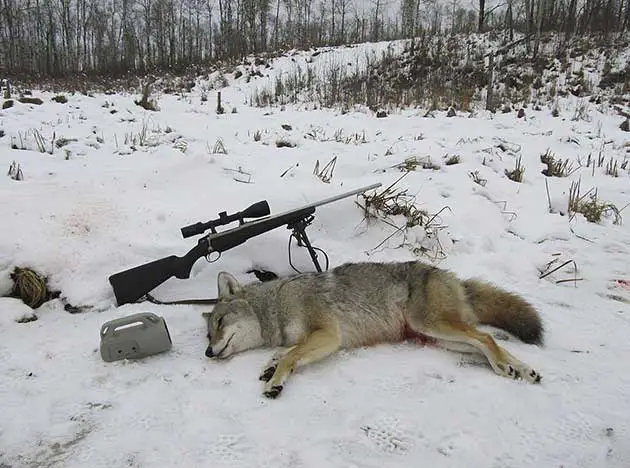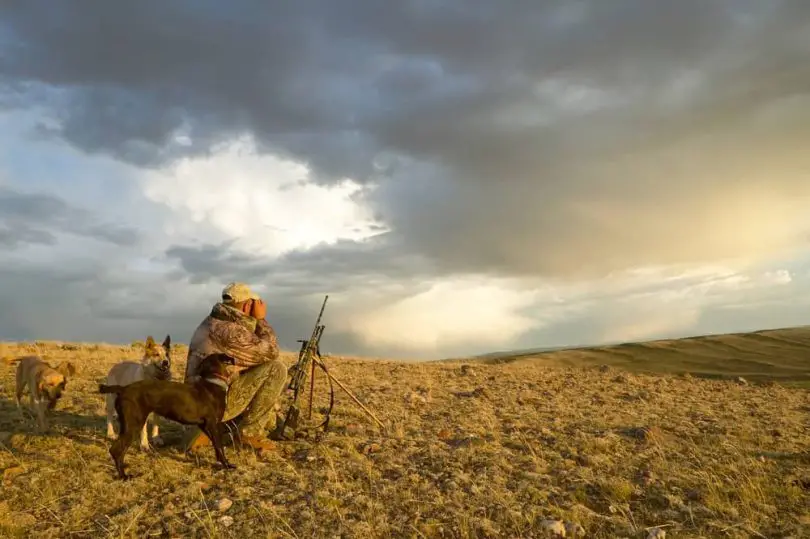Coyote hunting is a lot of fun for both beginner and seasoned hunters.
But these cunning critters can easily outsmart you if you don’t have the right skill, gear, and experience. Knowing when to look for coyotes is part of that skill.
Since coyotes are nocturnal, nighttime is definitely the best time for coyote hunting.
But some states may not allow you to hunt at night and in that case, you may have to try during the early morning or late afternoon.
Let’s dig deeper and see what is the best time for hunting coyote!
Best Time for Coyote Hunting: What to Keep in Mind

Time of Year
- Fall
The weather during fall is the right time for coyote hunting. Because the young pups then roam around without their parents.
So, you will get more success with these young dumb pups. Generally, use prey distress calls during this time.
- Winter
Mostly, predator hunters hunt coyotes during winter. The pups are then grown up and spend more time during the day hunting for food.
They become more active during the daytime because of the weather and so, they face food scarcity.
Change your methods based on the predators’ curiosity, hunger, paternal, and territorial instincts. As they hear more calls, they become wiser.
Try different calls, switch calls, and methods and get success. The 15th of February is the breeding season’s peak.
- Spring
The coyotes become more territorial by the spring and work in dens.
Use coyote vocals to call during this time. They will approach your prey distress call. But it is not so effective to combine with the coyote vocals.
Make your hunting more rewarding by using the howling call which means a challenge among coyotes.
Practice a lot to do that right.
Keep your patience during this time. Sit longer on a stand but not more than 30 mins if you know coyotes can be in that area. Stay longer if you hear a coyote.
- Summer
Generally, predator hunters take an off during summer.
Still, many hunters enjoy any type of hunting whether bowhunting or hunting with firearms in the summer. They mostly use decoy dogs to allure coyotes.
The best thing is to leave these predators alone for the summer to restore the population.
Time of Day
- Early Morning
Hunt in the early morning for being successful because animals remain most active then. A coyote will respond to a howl or siren.
Start pre-sunrise calls with a group howl, interrogation howl, and locator.
Wait and sit for three to four minutes, and begin any distress or howls based on the season.
- Late Morning
Hunt from dawn to 11 am. The coyotes will respond better then. Take your spotters and hunt as many as possible during the late morning.
- During Noon
Some people will suggest not to call coyotes during midday i.e. when you are having lunch. Again, keep in mind that coyotes are opportunists.
If they can get a chance of free meals, they can often approach there out of curiosity.
You will observe more coyotes at that time compared to other times while driving. Often take the chance of spotting and stalking them during noon.
- Late Afternoon
Late afternoon is challenging. But good locations, good scouting, and your good setup, as well as your approach, can bring you success.
During this part of the day, you mostly become lazy. You won’t check anything like the wind, or the sun, or won’t climb a hill to get a suitable spot.
You will find yourself off-guard when finally, you see a coyote near your decoy because of these things.
Call cayotes any time but with good techniques.
Some hunters in Arizona do their calling during the midday in the mid-summer by following excellent techniques.
- Evening
All animal activities pick up again in the evening. The same thing applies to the coyotes.
Your evening stand can be the most successful one. Have patience, and take a suitable stand, or sit when the sun sets.
- The phase of the Moon
Some hunters will suggest you not call cayotes during the daytime when the moon is full.
But cayotes can approach during a full moon, a waning, a waxing crescent, or even in no moon.
Full moons will make things difficult for you because coyotes see well enough at night, and they can effectively hunt then.
All cayotes are not the same. Some can be different. They burn many calories during winter hunts. They require eating whenever they have a chance.
So, don’t stop hunting based on the phase of the moon.









Leave a Comment